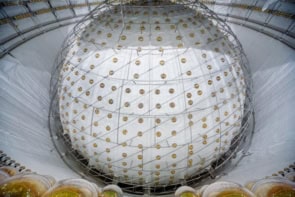Physicists may have discovered the first "hybrid meson" at the KEK laboratory in Japan. The meson, first predicted over 25 years ago, appears to contain a gluon in addition to the quark and antiquark that are usually found in mesons (S-K Choi et al. 2005 Phys. Rev. Lett. 94 182002). It is currently known as the Y(3940) because it has a mass of 3940 MeV/c2.
The new meson was observed in electron-positron collisions by the international Belle collaboration at KEK and quickly decays into two well-known particles called the Omega and J/psi. The properties of the decay have led the Belle team to believe that it is not a standard quark-antiquark particle but may be a hybrid meson containing a charm quark, a charm antiquark and a gluon. The existence of such hybrid charm-anticharm-gluon particles was first predicted theoretically in 1978.
Although many of the properties of Y(3940) match those expected for a hybrid meson, its mass — which is about the same as that of a single helium atom — is much lower than theory predicts. The Belle collaboration now hopes to solve this enigma by further analysing its data.
The new meson is the latest in a list of recent surprising discoveries in particle physics. These include several particles called pentaquarks (which may or may not exist) that contain five quarks, a particle called the X(3872) that appears to be made of four quarks, and another meson called the Ds(2317) that does not behave as predicted.



